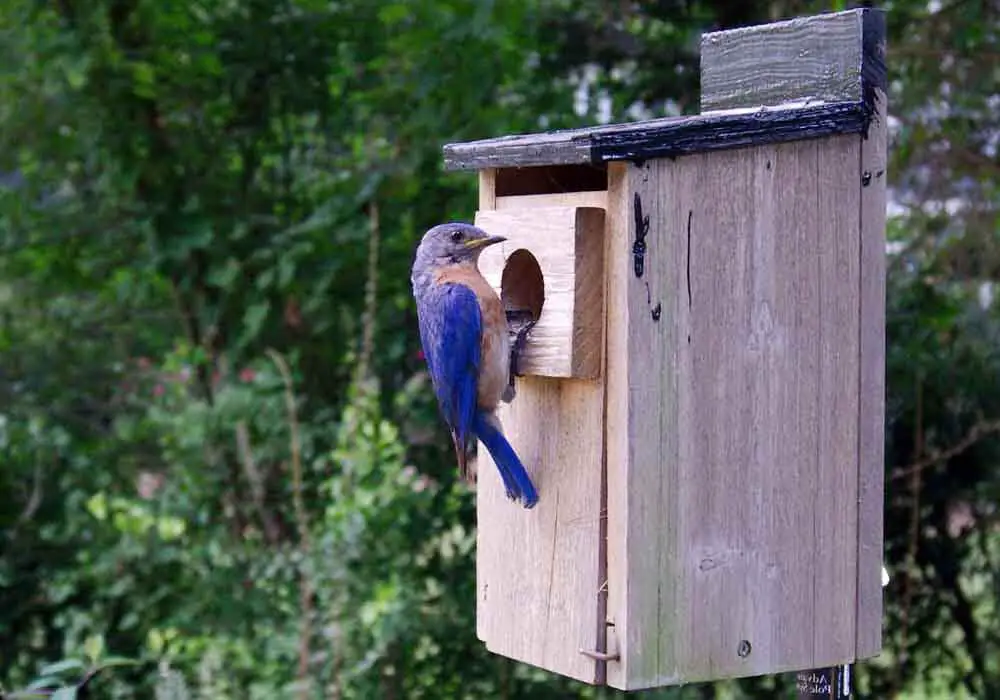Facts About Bluebird Houses
7 Important Things To Consider Before
Hanging A Bluebird Nest Box
Bluebirds are naturally cavity nesters that live in downed vegetation, fences, and trees. However, competition among bird species and modern construction materials have made it challenging for them to spot safe nesting sites. These birds love nest boxes, and it’s a great idea to put some bluebird houses in your yard. facts about bluebird houses
A bluebird house must be the right size to keep the birds comfortable and safe. It must have an entrance, be well-ventilated, watertight, and have drainage holes. The wood must also be rot-resistant, with the interior untreated and the exterior a light, neutral color.
Bluebirds can take several seasons to adapt to a new house and use it for nesting. In this article, I’ll discuss some facts about bluebird houses. Keep reading to learn about the right size for your bluebird houses, where to place them, the direction they should face, and how far apart to space them.

Do Bluebirds Need a Special Birdhouse?
Bluebirds need a special birdhouse built to attract and protect them while deterring competitors. These cavity-nesting birds need safe and secure nesting sites to raise their young. Bluebirds are timid; therefore, a bluebird house must be the right size to keep more aggressive birds out.
A bluebird house should have the following characteristics:
- Suitable size: Bluebird houses are usually 8 - 12 inches (20 - 30 cm) high and 5 inches (12 cm) wide. The entry hole should be at approximately ⅔ of the height to keep growing hatchlings from tumbling out and prevent predators from reaching the young birds.
- Sound construction: A bluebird house should be made of rot-resistant wood, such as cedar. The interior should be untreated, but the exterior can be painted a neutral, light color. It must also be well-ventilated and watertight. The rear should be taller, and the roof should slope towards the front to provide shade and cover over the entry hole.
- Suitably-sized opening: The size of the entry space is critical in keeping out predatory birds. A round hole should be about 1½ inches (4 cm) wide, while a slot entrance should be 1 ⅛ (3 cm) wide. An oval entry should be vertical and measure about 2 ¼ inches (6 cm).
- No perch: A bluebird house should be away from any perch because of predators and competing birds. Adding grippers to the hole opening prevents nestlings from falling off when they first venture out of the birdhouse.
- Easy to monitor: Every bluebird house should have a hinge on the side or top to allow cleaning in the off-season.
Where To Place Bluebird Houses?
You should place bluebird houses in an open area with a lot of short grass for the birds to catch insects and scattered trees for them to perch. The nest box should be more than 50 feet (15 meters) away from wooded or bushy areas, away from buildings, and about 5 feet (1.5 meters) above the ground.
Proper habitat is essential for bluebird houses, and even a well-built house will not be helpful if the birds do not like the positioning. When placing a nestbox, consider a spot where it will face an open grass expanse. If possible, put it on one side of your yard overlooking the rest of the property. A nest box in an open area has a higher chance of attracting bluebirds.
Organic farmland, with tree lines and fences bordering the open area, is the perfect habitat for a bluebird house. In developed areas, you will likely find bluebirds in large open lawns, parks, golf courses, cemeteries, quiet roadways, and old railroad paths. Bluebirds usually avoid city centers and heavy woods.
Bluebirds mainly feed on insects during summer, and open areas near a forest edge or with few trees are best for setting up bluebird houses. A little underbrush draws out insects for the birds to eat, but too much of it covers the insects.
Never mount your bluebird houses too close to buildings, such as barns or houses. House sparrows thrive next to man-made structures, especially if animal feed or food scraps are nearby. These larger, invasive species are bluebirds’ main competitors, and are naturally attracted to nest boxes next to a house or a barn.

Learning the nesting behaviors of Bluebirds can go a long way to understanding what they like in a house in the first place. We've written an article dedicated to explaining these Bluebird nesting habits in depth.
How High Should You Put a Bluebird House?
You should put a bluebird house on a pole about 5 feet (1.5 m) above the ground to keep off climbing predators. Animals like cats, raccoons, and snakes might reach the box if it is too low. However, bluebirds will still nest in boxes set at 15 feet (4.5 m) high or even 3 feet (0.9 m) off the ground.
A general rule is to set up the next box with its entrance at eye level because this is the perfect way to keep the birdhouse high enough off the ground.
The birdhouse will be convenient for you to watch and not too low if you can stand up straight and look directly into the entrance. You can mount your bluebird house higher, but not lower, to avoid crawling predators.
A wooden or metal pole is an ideal mount for a bluebird house. Add a baffle to the post or grease it to stop raccoons from climbing up the rod. A predator guard at the entrance prevents animals from reaching the young ones. Never mount a bluebird house on a tree or a fence post because climbing predators can get to it.
How Many Bluebird Houses per Acre?
You should have up to six bluebird pairs per acre. Bluebirds are territorial, with each male claiming 2 - 3 acres (0.8 - 1.2 hectares) as his territory. You must provide adequate spacing to put up multiple bluebird houses.
One of the exciting facts about bluebird houses is that two different bluebird couples will not use nest boxes mounted too close together. Therefore, place the boxes at least 100 feet (30.48 meters) apart to avoid fights and confrontations between the birds. Appropriate spacing also allows mating pairs to retain their territories peacefully.

How do you attract Bluebirds to your birdhouse? There's alot more to it than meets the eye. We've written a great article here that covers all you'll need to know and gives you insider secrets as well!
How Far Apart Should Bluebird Houses Be?
Bluebird houses should be at least 100 yards (91 m) apart because bluebirds are competitive and territorial. The spacing provides adequate space for the birds to feel secure. The spacing should be 100-300 yards (91-274 m) when setting up a bluebird trail.
To attract multiple bluebird pairs to your yard, you should space the birdhouses at varying distances depending on the bluebird species:
- Mountain Bluebirds - between 200 - 300 yards (183-274 m)
- Western Bluebirds - About 100 yards (91 m), preferably 200 - 300 yards (183-274 m)
- Eastern Bluebirds - About 100 yards (91 m), preferably 125 - 150 yards (114 - 137 m)
Which Direction Should a Bluebird House Face?
A bluebird house should face the direction away from the hot midday sun, rain, and prevailing winds. Although the location should be open and sunny, the birdhouse should receive moderate direct sunlight.
Bluebird houses should also face an open area with a tree, a shrub, or other perch where fledglings can land on their first flight. However, they should not face large bushes, which are the perfect hiding spots for wrens.
Bluebirds often prefer east-facing boxes to avoid winds, storms, and overheating from the afternoon sunlight.
Their preference in descending order is:
- East
- North
- South
- West
An opening to the east is best, but keep in mind the wind and sun the box will receive and place it accordingly.
When To Clean Out Bluebird Houses?
You should clean out bluebird houses before the nesting season begins. Also, clean up the birdhouse after every brood fledges to encourage the mating pair to raise more chicks in the same nest box.
At a minimum, you should clean your birdhouse at least once a year. You should also repair any damage and remove the used nest and any debris that has been collected.
By cleaning the box at least annually, you help eliminate any disease or parasites, and keep the birdhouse usable for longer. Keeping your bluebird house clean throughout the season will provide a snug and safe spot for repeated egg broods.

Knowing when, and how to clean out your Bluebird house will help to prevent disease spread as well as making it more appealing to birds. Here's a helpful article of ours that explains how to do so!
Facts About Bluebird Houses...Final Thoughts
In this article, I have explained some facts about bluebird houses. It may take a while before bluebirds get comfortable enough to use your nest box, but they will raise different families in one place for years. Once they enter your property, you will enjoy being a bluebird landlord.
Back To The TOP Of This Facts About Bluebird Houses Page

About the Author...
Richard Worden, a dedicated bird lover for over 20 years, I love to share my in-depth knowledge and passion for birds. Read more About Me and my expertise in this field.
- We Know Birds HOME ›
- Bluebird Facts and Information ›
- Facts About Bluebird Houses
